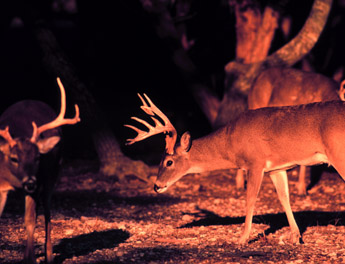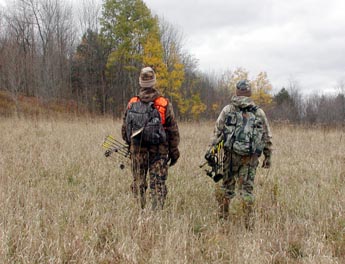There are places in the Eastern United States where a bowhunter has a legitimate shot at killing a trophy deer. There are places, too, where an archer might see a big black bear wander by.
But only in a few places can a sportsman carry a bow into the woods knowing he might see a wall-hanging buck, a rug-sized bear or a motorcycle-sized European wild boar stroll past his stand.
Such places do exist, tucked deep in the steep-sided hollows of southern West Virginia. And thanks to regulations put in place by the state’s Division of Natural Resources, bowhunters can legally take any of the three during a five-week mid-autumn window.
“It’s a variation on a season Virginia had a few years ago,” says Curtis Taylor, the DNR’s chief of wildlife resources. “Their season let you kill deer, bear and turkey on the same day. Ours just swaps turkey with wild boar.”
The mountains are steep-sided leg-busters, covered with greenbrier thickets, laurel hells and slippery clay soil. Guide services are nonexistent. Lodging is sparse and Spartan. Driving the region’s twisting roads can be a nerve-racking experience punctuated by axle-bending potholes and seemingly demented coal-truck drivers. But for those bowhunters motivated and determined enough to brave the area, the big-game rewards can be spectacular.
Four of West Virginia’s last five archery-record bucks have come from counties where the archery triple play is possible. Bears are almost too plentiful throughout the region, and 300- to 500-pounders are nearly common.
Boars aren’t nearly as abundant, so they constitute the limiting factor in any bowhunter’s quest for a big-game sweep. Once relatively widespread over a four-county area, the European transplants have suffered a decade-long population decline–a decline that has prompted DNR officials to declare them off-limits to nonresidents.
All three are available to resident hunters, however, and the two species with the greatest trophy potential–deer and bear–remain open to any bowhunter willing to pony up the price of a license.
REGULATIONS PAY OFF
It wasn’t always this way. A quarter-century ago, even the best hunter would have been hard-pressed to locate a deer or a bear within 50 miles of today’s most trophy-rich hollows. DNR officials began transplanting boars into the region in 1971 precisely because there weren’t many deer or bears left to hunt.
A change of deer-hunting regulations in 1979, however, transformed much of West Virginia into one of the nation’s best trophy whitetail haunts–a status it retains to this day.
Four counties–Logan, Wyoming, Mingo and McDowell–were declared “bowhunting only” that year. By 1985, the region produced its first record archery kill, a 17-point non-typical that scored 212 1/4 Pope and Young points. Four more record bucks have been taken in those counties since 1995. Last year, the four counties produced 39 Pope and Young-class trophies, a whopping 60 percent of the statewide total.
Two years before the region’s deer population began its turnaround, a change in the state’s bear-hunting regulations sparked an explosion in the bruin population. Starting the season a week later than usual allowed pregnant sows just enough time to den up before the shooting started.
Bear numbers quickly rebounded, and the oak-rich forests of the state’s southern mountains provided ideal habitat for the species’ expansion. By the early 1990s, more bears existed in the southern counties than in the rest of the state combined.
District biologist Tom Dotson, engaged in research on the bears, says most of the bruins under study–taken at random from the wild–weigh more than 300 pounds. One caught earlier this year weighed 570, and another went 565. Those are big bears in anybody’s book.
SCOUTING THE RIDGE
This year’s buck-bear-boar opportunity will last 36 days, from October 18 to November 22. Dotson says that to have a reasonable chance at all three species, hunters will need to concentrate on a relatively narrow area along the boundary between Boone and Logan counties.
“From Route 17 on the west side to Route 85 on the east–and from Wharton on the north down to Blair Mountain on the south–is where someone would have the best chance of taking a boar,” he says.
The area encompasses roughly 16 square miles of extremely hilly, extraordinarily rugged territory. Luckily, hundreds of miles of four-wheel-drive and ATV trails crisscross the slopes and ridges. Access isn’t a problem because the coal and timber corporations that own the land allow free access to most of it.
“Most of the hogs are centered in the head of the Spruce Laurel Fork drainage and over onto Blair Mountain,” he says. Bear densities are especially good on Cook Mountain, the ridge immediately east of the Spruce Laurel drainage system. Finding a deer should be easy, according to Dotson, because they’re everywhere.
Dotson says the best way for outsiders to locate any of the three species is to scout the many points that extend off the region’s serpentine ridges.
For more information, contact the West Virginia Division of Natural Resources’ Wildlife Resources Section, State Capitol Complex, 1900 Kanawha Blvd. E, Charleston, WV 25305; 304-558-2771. Hunting licenses, stamps and permits are available online at www.wvhunt.com.
For more regional information, go to www.outdoorlife.com/regional


